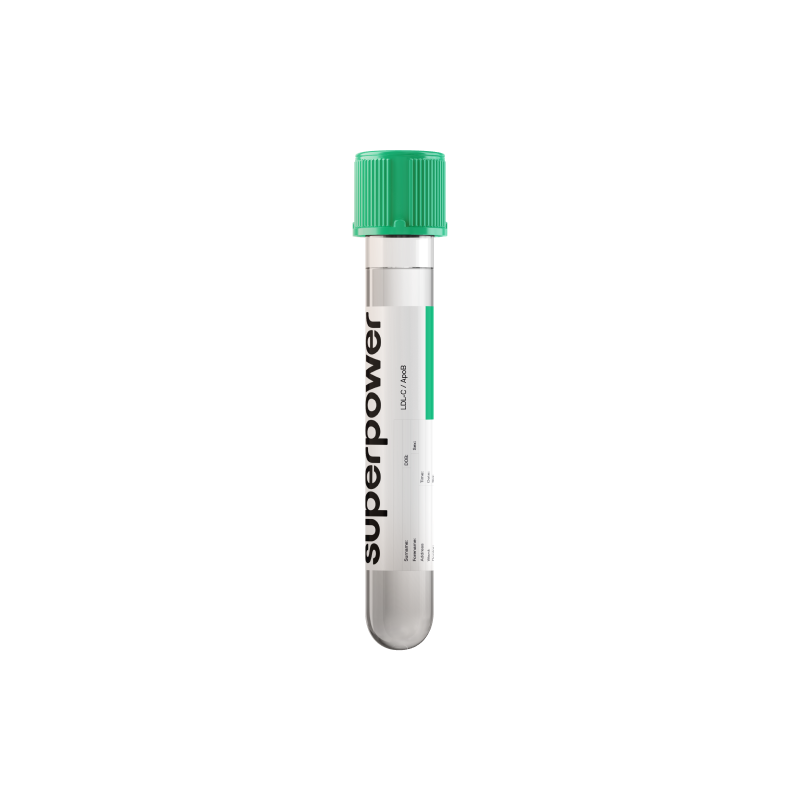Track LDL-C and ApoB to understand cardiovascular risk and cholesterol health. Clear results, guided insights, and personalized data for prevention.
Key Benefits
See your artery-clogging particle load to gauge heart and stroke risk.
- Spot hidden risk when LDL-C seems normal but ApoB is elevated.
- Guide treatment intensity and targets based on risk and ApoB/LDL-C levels.
- Track how diet, weight loss, and medicines lower artery-clogging particle number.
- Clarify familial hypercholesterolemia likelihood and prompt cascade screening for relatives.
- Explain how insulin resistance or high triglycerides raise ApoB-based cardiovascular risk.
- Protect pregnancy health by optimizing lipids to reduce hypertensive and placental risks.
- Best interpreted with non-HDL-C, triglycerides, Lp(a), blood pressure, and diabetes risk.
What is LDL-C / ApoB?
LDL-C is the amount of cholesterol carried inside low-density lipoprotein particles (LDL). These particles are made by the liver as very-low-density lipoproteins (VLDL) are remodeled in the bloodstream. Each LDL particle contains a single molecule of apolipoprotein B-100 (ApoB). ApoB is the structural protein present on all cholesterol-carrying, artery-entering lipoproteins—VLDL, intermediate-density lipoproteins (IDL), LDL, and lipoprotein(a) [Lp(a)]. Because each of these particles carries one ApoB, the ApoB level in blood reflects how many atherogenic particles are circulating, not how much cholesterol each one holds.
LDL particles deliver cholesterol to cells throughout the body via the LDL receptor, supporting cell membranes, steroid hormone production, and bile acid synthesis. ApoB acts as the scaffold that lets these particles form in the liver, enter the circulation, and be recognized by receptors (ligand for the LDL receptor). In simple terms, LDL-C tells you the cholesterol cargo inside LDL, while ApoB tells you how many cargo carriers are on the road—two complementary views of the body’s cholesterol transport system.
Why is LDL-C / ApoB important?
LDL-C is the cholesterol mass carried inside LDL particles, while ApoB is the single protein “tag” on every atherogenic particle (VLDL, IDL, LDL, and Lp(a)), so it counts how many artery-penetrating particles are in circulation. These particles deliver cholesterol to tissues; when they are in excess, they enter vessel walls, trigger inflammation, and form plaques that can limit blood flow to the heart, brain, kidneys, and limbs.
Reference intervals vary by lab and age, but risk generally falls as LDL-C and especially ApoB move toward the lower end of the range. ApoB tracks particle number, so discordance can occur: a “normal” LDL-C with a higher ApoB still signals elevated particle burden.
When values are low, it reflects efficient clearance and fewer circulating atherogenic particles. Most adults have no symptoms and enjoy lower lifetime plaque accumulation. Extremely low levels from rare genetic conditions in infants and children can impair fat-soluble vitamin transport, growth, vision, and nerve function; outside of those states, very low levels are typically well tolerated. Premenopausal women often have lower levels than men at similar risk.
When values are high, there are many ApoB particles delivering and depositing cholesterol in arterial walls, accelerating atherosclerosis. This is usually silent for years, then may present as angina, heart attack, stroke, or claudication. Very high levels (often hereditary) can produce tendon xanthomas and corneal arcus. Levels rise physiologically in pregnancy and tend to climb after menopause.
Big picture: ApoB/LDL-C integrate liver metabolism, hormonal needs, and lipoprotein transport with vascular biology. Their long-term, cumulative exposure drives atherosclerotic risk and interacts with triglycerides, HDL-C, Lp(a), insulin resistance, thyroid, kidney, liver function, and inflammation to shape cardiovascular outcomes.
What Insights Will I Get?
What LDL‑C / ApoB tells you
LDL cholesterol (LDL‑C) is the amount of cholesterol carried inside LDL particles; apolipoprotein B (ApoB) is the count of atherogenic particles themselves (each LDL, VLDL, IDL, and Lp(a) has one ApoB). Together they index how the body transports energy and building blocks—cholesterol for cell membranes, myelin, steroid hormones, and bile acids—and how many particles can enter artery walls and drive atherosclerosis.
Low values usually reflect reduced production or enhanced clearance of ApoB‑containing lipoproteins. This occurs with higher thyroid activity, low hepatic production, malabsorption, severe illness, or inherited low‑ApoB states. Systems‑level effects include fewer atherogenic particles and, when very low, potential issues with fat‑soluble nutrient transport or hepatic fat in rare genetic conditions. Pregnancy normally raises these markers; unexpectedly low values in late gestation are atypical.
Being in range suggests adequate cholesterol delivery for membrane integrity and hormone synthesis without excessive particle burden. For cardiovascular risk, consensus places “optimal” toward the lower end of usual lab ranges, especially for ApoB, because particle number tracks risk more tightly than LDL‑C alone.
High values usually reflect increased particle number or impaired clearance—insulin resistance with VLDL overproduction, too little thyroid hormone, nephrotic syndrome, cholestasis, or familial hypercholesterolemia. The net effect is more particles interacting with the endothelium, promoting plaque formation and raising cardiovascular and cerebrovascular risk. Levels rise with age; men and postmenopausal women tend to have higher values. Pregnancy physiologically increases LDL‑C/ApoB in mid–late gestation.
Notes: Nonfasting sampling minimally affects ApoB; LDL‑C is often calculated and can be biased when triglycerides are high. Acute illness can transiently lower LDL‑C. Medications (statins, thyroid hormone, estrogens, retinoids) and elevated Lp(a) influence results. Assay methods and reference ranges vary by lab.



.svg)



.png)
.png)
.png)
.png)








